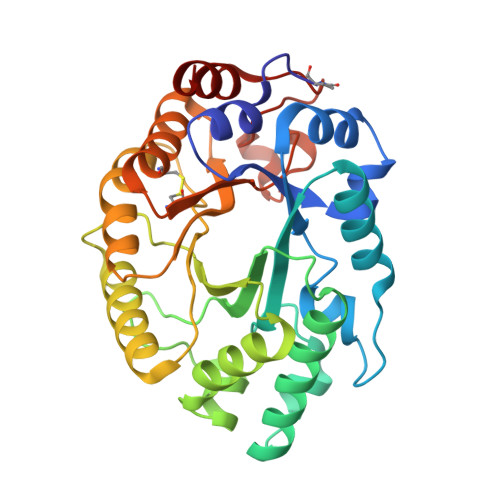A Family 10 Thermoascus Aurantiacus Xylanase Utilizes Arabinose Decorations of Xylan as Significant Substrate Specificity Determinants.
Vardakou, M., Flint, J., Christakopoulos, P., Lewis, R.J., Gilbert, H.J., Murray, J.W.(2005) J Mol Biol 352: 1060
- PubMed: 16140328
- DOI: https://doi.org/10.1016/j.jmb.2005.07.051
- Primary Citation of Related Structures:
2BNJ - PubMed Abstract:
Xylan, which is a key component of the plant cell wall, consists of a backbone of beta-1,4-linked xylose residues that are decorated with arabinofuranose, acetyl, 4-O-methyl d-glucuronic acid and ferulate. The backbone of xylan is hydrolysed by endo-beta1,4-xylanases (xylanases); however, it is unclear whether the various side-chains of the polysaccharide are utilized by these enzymes as significant substrate specificity determinants. To address this question we have determined the crystal structure of a family 10 xylanase from Thermoascus aurantiacus, in complex with xylobiose containing an arabinofuranosyl-ferulate side-chain. We show that the distal glycone subsite of the enzyme makes extensive direct and indirect interactions with the arabinose side-chain, while the ferulate moiety is solvent-exposed. Consistent with the 3D structural data, the xylanase displays fourfold more activity against xylotriose in which the non-reducing moiety is linked to an arabinose side-chain, compared to the undecorated form of the oligosacchairde. These data indicate that the sugar decorations of xylans in the T.aurantiacus family 10 xylanase, rather than simply being accommodated, can be significant substrate specificity determinants.
Organizational Affiliation:
Biotechnology Laboratory, Chemical Engineering Department, National Technical University of Athens, 5 Iroon Polytechniou Str, Zografou Campus, 15780, Athens, Greece.

















